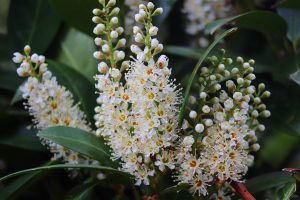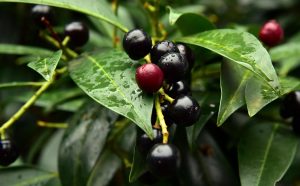Cherry laurel is a popular evergreen shrub widely used in landscaping due to its dense foliage and fast growth. However, despite its benefits, it comes with several disadvantages that homeowners and gardeners should consider before planting.
Some of these drawbacks include toxicity, invasive tendencies, maintenance challenges, and susceptibility to pests and diseases.
Understanding these disadvantages can help you make an informed decision about whether cherry laurel is the right choice for your garden.
This article explores the 10 biggest drawbacks of cherry laurel and provides insights on managing its negative aspects.
Related: Best Fertilizer For Cherry Laurel
What Are The Disadvantages Of Cherry Laurel? Find 10 Best
1. Toxicity to Humans and Animals
Cherry laurel contains cyanogenic glycosides, which are toxic compounds that can be harmful to both humans and animals. When ingested, these compounds can release hydrogen cyanide, leading to symptoms such as dizziness, difficulty breathing, and, in extreme cases, fatal poisoning.
Pets, livestock, and even small children who accidentally consume the plant’s leaves or berries may experience severe health issues. This toxicity makes cherry laurel a risky choice for gardens where pets and children play frequently.
Beyond ingestion risks, cherry laurel can also cause skin irritation upon contact, particularly for individuals with sensitive skin. Handling the plant without gloves can lead to rashes, redness, or itching due to the toxic sap present in the leaves and stems. Proper disposal of trimmed branches and leaves is essential to prevent accidental poisoning.
Gardeners who choose to plant cherry laurel should take extra precautions, such as installing barriers or regularly monitoring for fallen berries that might be eaten by unsuspecting animals.
Key concerns:
- Dangerous if ingested
- Harmful to pets and livestock
- Can cause respiratory distress
- Requires caution around children
- Toxic even in small amounts
- Needs proper disposal
- Can cause skin irritation
2. Invasive Growth
Cherry laurel is known for its aggressive spreading habit, often outcompeting native vegetation. Due to its rapid growth rate, it can quickly take over gardens, forests, and natural landscapes if not properly maintained. Its ability to self-seed prolifically means that even a single plant can lead to widespread growth, making it challenging to control.
This invasive nature can disrupt local ecosystems by reducing biodiversity and replacing native plant species that provide better ecological benefits.
Controlling the spread of cherry laurel requires regular pruning, removal of seedlings, and sometimes even chemical intervention. The dense canopy it creates blocks sunlight from reaching the ground, preventing the growth of other plants beneath it.
Over time, this can result in a monotonous, impenetrable thicket that is difficult to remove. Homeowners and landscapers should consider these factors before planting cherry laurel, especially in regions where it is classified as an invasive species.
Key concerns:
- Spreads uncontrollably
- Difficult to eradicate
- Requires constant pruning
- Outcompetes native vegetation
- Can damage garden aesthetics
- Expensive to remove
- May become a nuisance
3. High Maintenance Requirements
Cherry laurel demands consistent upkeep to prevent it from becoming overgrown. Its rapid growth means it requires frequent trimming, sometimes multiple times a year, to maintain a desirable shape and prevent it from taking over garden spaces.
If left untrimmed, cherry laurel can quickly form a dense hedge that blocks pathways, windows, and sunlight, reducing the aesthetic appeal of the landscape.
The maintenance burden extends beyond pruning, as cherry laurel sheds a significant amount of leaves and debris throughout the year.
This debris can clog gutters, litter lawns, and require frequent cleanup. Additionally, due to its dense growth, pruning tools such as shears and electric trimmers may be necessary, adding to maintenance costs. Homeowners should assess their ability to keep up with the demanding care routine before choosing cherry laurel as a landscape plant.
Key concerns:
- Needs frequent trimming
- Can grow out of control
- Generates large amounts of debris
- Time-consuming maintenance
- Can require professional trimming
- Affects nearby plants
- Pruning tools may be needed
4. Susceptibility to Pests and Diseases
Despite its hardy nature, cherry laurel is highly susceptible to pests like aphids, scale insects, and caterpillars. These pests feed on the leaves, causing discoloration, leaf curling, and weakened plant health.
Severe infestations may lead to stunted growth or defoliation, reducing the plant’s effectiveness as a hedge or privacy screen. Controlling these pests often requires chemical treatments, which may not be ideal for organic gardeners.
In addition to insect pests, cherry laurel is prone to fungal diseases such as powdery mildew and shot hole disease. These infections cause brown spots, leaf drop, and overall decline in plant health.
Wet, humid conditions exacerbate these problems, making cherry laurel less suitable for regions with frequent rainfall. Regular monitoring and preventive care, including fungicidal applications, may be necessary to keep the plant healthy.
Key concerns:
- Attracts harmful pests
- Requires pesticides
- Prone to fungal infections
- Can weaken over time
- May require chemical treatments
- Susceptible to leaf discoloration
- Can become unsightly
5. Potential for Root Damage
Cherry laurel has an extensive root system that can become problematic for homeowners. The aggressive roots can invade underground utilities such as water pipes, septic tanks, and drainage systems, leading to costly repairs. In urban and suburban areas, cherry laurel’s roots can lift pavements, disrupt sidewalks, and damage driveways, creating safety hazards.
Beyond structural damage, cherry laurel roots compete with other plants for nutrients and water, potentially stunting the growth of nearby vegetation. Once established, removing cherry laurel can be difficult due to its deep, resilient root system. If planted too close to structures or gardens, it may require professional intervention to prevent long-term issues.
Key concerns:
- Roots can invade pipes
- Damages nearby structures
- Difficult to remove once established
- Can cause soil depletion
- Limits growth of nearby plants
- Roots are difficult to manage
- Can affect property value
6. Limited Wildlife Benefits
Unlike native shrubs, cherry laurel provides minimal benefits to local wildlife. While it does offer dense cover for some birds, its berries are not a preferred food source for many species. Instead, the toxic nature of its berries can deter some animals, reducing biodiversity in the garden.
Cherry laurel also lacks significant nectar production, making it less attractive to pollinators such as bees and butterflies. Native plants that offer better food sources and ecological contributions are often a superior choice for supporting local wildlife populations.
Those looking to create a thriving, wildlife-friendly garden should consider alternative species that provide essential habitat and nourishment.
Key concerns:
- Not beneficial to pollinators
- Limited food source for birds
- Can reduce local plant diversity
- Not ideal for ecological balance
- May discourage beneficial insects
- Doesn’t support soil health
- Disrupts native plant habitats
7. Unpleasant Odor When Cut
One often-overlooked drawback of cherry laurel is the unpleasant smell released when its leaves are cut or bruised. This odor, similar to bitter almonds, is caused by the release of cyanogenic compounds. While some may find the scent tolerable, many gardeners report discomfort, especially when pruning large hedges or removing overgrown sections.
The lingering odor can be particularly bothersome in enclosed spaces or areas with limited airflow. Gardeners sensitive to strong scents may find working with cherry laurel unpleasant.
Additionally, the release of cyanide-related compounds can cause mild respiratory irritation, making it advisable to wear protective gear when handling the plant. Proper disposal of trimmings is necessary to prevent the smell from persisting in compost piles or garden waste bins.
Key concerns:
- Strong chemical scent
- Can be unpleasant to gardeners
- May cause respiratory discomfort
- Lingers after cutting
- Can affect nearby outdoor areas
- Deters some homeowners
- Requires careful handling
Disadvantages Of Cherry Laurel FAQs
1. Is cherry laurel poisonous to dogs? Yes, cherry laurel is toxic to dogs and can cause serious health issues if ingested.
2. How fast does cherry laurel grow? Cherry laurel can grow up to 2 feet per year, making it one of the fastest-growing hedge plants.
3. Can you burn cherry laurel wood? It is not recommended, as burning cherry laurel releases toxic fumes that can be harmful to humans and animals.
4. Does cherry laurel attract bees? Cherry laurel flowers can attract bees, but the plant itself does not significantly support pollinators compared to native species.
5. How do you control cherry laurel growth? Regular pruning, root barriers, and selective herbicide application can help control its spread.
6. Can cherry laurel survive winter? Yes, it is highly resilient and can withstand cold temperatures, but extreme frost may cause leaf damage.
7. Does cherry laurel require fertilization? While not always necessary, occasional fertilization can promote healthier growth and resistance to diseases.
Conclusion
Cherry laurel, despite its popularity, comes with several disadvantages that gardeners should carefully consider. Its toxicity, invasiveness, high maintenance, and susceptibility to pests make it a challenging plant to manage.
While it provides fast-growing privacy, the drawbacks may outweigh the benefits for some homeowners. Before planting cherry laurel, evaluate your landscape needs and maintenance capacity.
If you are seeking alternatives, consider native plants that provide similar benefits without the associated risks. For more expert gardening tips, subscribe to our newsletter and stay informed about the best plant choices for your garden.
Recent Posts
Repotting orchids is essential for healthy growth, but it is also one of the most common ways orchid owners accidentally harm their plants. Many mistakes happen because orchids have very different...
Repotting orchids is essential for maintaining healthy roots and ensuring vibrant blooms. Choosing the right mix for repotting orchids directly affects moisture retention, aeration, and overall plant...